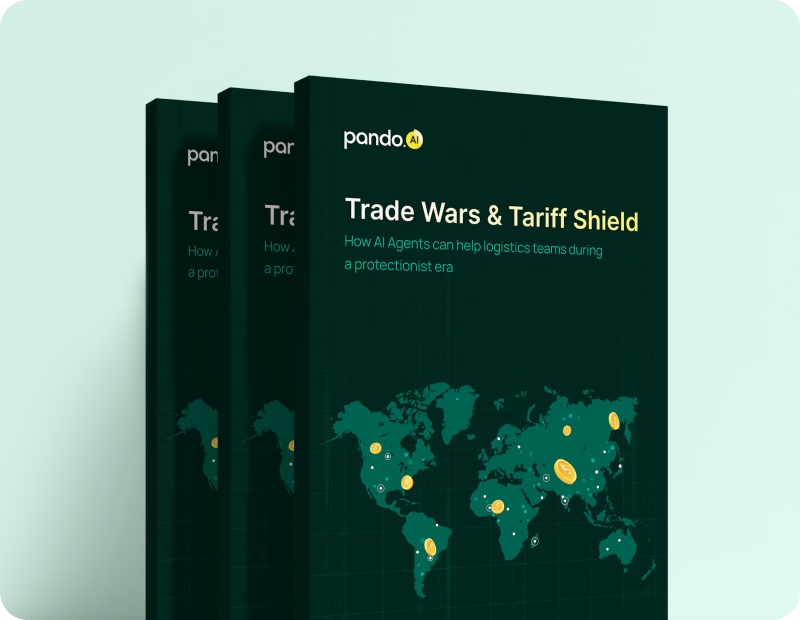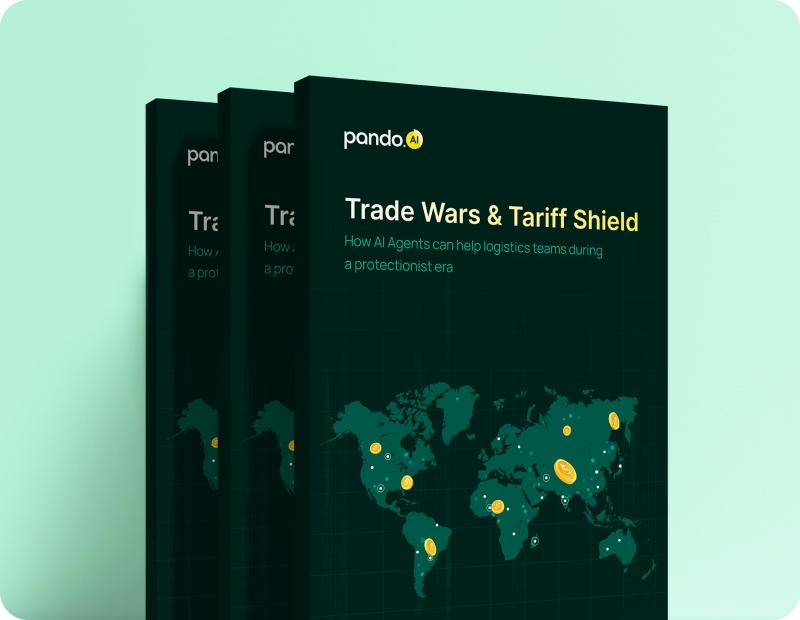-
Products Products
- Industry
- Initiatives
- Resources
- Company
- Book a demo

Before you go: Logistics leaders just dropped the truth on AI
The State of AI in Logistics 2025 is here — no hype, just real conversations and raw insights.
Industry landscape and supply chain trends reshaping the Consumer-Packaged Goods (CPG) Industry – Part 2
Discover how cutting-edge technologies and innovative strategies are reshaping the way products reach your shelves.
Published on September 6, 2024 • 6 mins read
Durga Pratiha

Discover how cutting-edge technologies and innovative strategies are reshaping the way products reach your shelves.
In our previous post, we delved deep into the dynamics of the Consumer-Packaged Goods (CPG) industry and its impact on your daily life. Now, let's dive into the world of supply chain and logistics trends that are transforming how your favorite products reach your shopping cart.
As a consumer, you might not think much about supply chains when you grab a bottle of shampoo or a pack of cookies. But behind every product on your shelf is a complex network of processes that bring it from raw materials to your home. Understanding these trends will not only give you a newfound appreciation for the products you use daily but also help you become a more informed consumer.
Let's explore 10 key trends that are reshaping the CPG supply chain landscape:
1. Artificial Intelligence (AI) and Machine Learning (ML):
AI and ML are revolutionizing the CPG supply chain by enhancing demand forecasting, inventory management, and route optimization. Companies like Procter & Gamble leverage these technologies to analyze vast datasets, including weather patterns, social media trends, and historical sales data. This allows them to predict consumer demand more accurately, ensuring products are stocked precisely when needed. For consumers, this means fewer out-of-stock situations and fresher products on shelves. Additionally, AI-driven analytics help companies optimize their supply chains, reducing waste and improving overall efficiency, which can lead to cost savings.
2. Internet of Things (IoT) and Smart packaging:
The integration of IoT devices into packaging and the supply chain is enhancing real-time monitoring of product location, temperature, and condition. This is particularly crucial for temperature-sensitive goods like dairy, pharmaceuticals, and fresh produce. For instance, smart packaging can alert both retailers and consumers when a product is nearing its expiration date, reducing waste and ensuring better quality control. Companies like Unilever are exploring IoT-enabled ice cream cabinets that monitor stock levels and temperature to maintain optimal freshness. This technology not only improves product quality but also enhances consumer trust in the freshness and safety of their purchases.
3. Blockchain for transparency:
Blockchain technology is providing unparalleled transparency in the CPG supply chain by creating an immutable record of a product's journey from its source to the store shelf. This technology allows consumers to verify the authenticity and ethical sourcing of products, which is increasingly important in today's market. For example, Walmart uses blockchain to trace the origin of its mangoes, reducing the time needed to track their source from days to seconds. This transparency builds consumer trust and enables more informed purchasing decisions, especially in categories like organic food, where authenticity and traceability are critical.
4. Sustainable and circular supply chains
As environmental concerns grow, CPG companies are increasingly adopting sustainable and circular supply chains. This involves using recycled materials, reducing waste, and implementing reverse logistics systems that allow for the collection and reuse of packaging. Nestlé, for instance, has committed to making 100% of its packaging recyclable or reusable by 2025. Such initiatives not only reduce the environmental impact but also resonate with eco-conscious consumers. By choosing products with sustainable packaging, consumers actively contribute to the demand for environmentally responsible practices, encouraging more companies to adopt similar initiatives. For a deeper dive into how sustainable practices are transforming supply chains, check out this insightful blog on the circular economy in supply chains.
5. Last-mile innovation
The last mile of delivery—the final step from distribution center to consumer—is one of the most challenging and costly segments of the supply chain. However, it's also an area ripe for innovation. Companies are experimenting with drone deliveries, autonomous vehicles, and crowd-sourced delivery services to improve speed and efficiency. Amazon’s Prime Air, which aims to deliver packages by drone in under 30 minutes, is a prime example of this trend. These advancements in last-mile logistics promise faster delivery times and can reduce delivery costs, making online shopping even more convenient and accessible.
6. Automation and robotics
Automation and robotics are transforming the operations of warehouses and distribution centers, making them faster and more efficient. Automated systems can handle a much larger inventory than traditional methods, ensuring products are picked, packed, and shipped with minimal human intervention. Companies like Walmart have embraced this technology, utilizing systems like Symbotic and Alphabot in their warehouses to fulfill online grocery orders quickly and accurately. For consumers, this means a broader selection of products available for rapid delivery and a more reliable and consistent shopping experience, particularly for online grocery purchases.
7. Personalization and mass customization
The flexibility of modern supply chains is enabling CPG companies to offer personalized and mass-customized products without significantly increasing costs. This trend is evident in products like Coca-Cola’s Freestyle machines, which allow consumers to mix and match flavors to create their own unique beverage combinations. Advances in production and distribution allow companies to cater to individual preferences on a large scale, offering products tailored to specific tastes and needs. For consumers, this trend means a greater variety of options and the ability to enjoy products that better align with their personal preferences and lifestyle choices.
8. Digital twins
Digital twins are virtual replicas of physical supply chains that enable companies to simulate and optimize processes before implementing changes in the real world. This technology allows businesses to test various scenarios, predict potential issues, and make data-driven decisions to improve efficiency and resilience. For instance, Unilever uses digital twins to enhance its supply chain operations, identifying bottlenecks and optimizing routes. This proactive approach can lead to more reliable product availability and cost savings, which may be passed on to consumers. As companies continue to refine their operations with digital twins, the overall supply chain becomes more robust and efficient.
9. 5G and edge computing
The rollout of 5G networks and the adoption of edge computing are transforming data processing within the CPG supply chain. These technologies enable faster, more reliable data transmission and processing closer to the source, which is critical for real-time inventory tracking and responsive logistics. In the retail environment, 5G and edge computing can support innovations like smart shelves that automatically update prices or augmented reality experiences that provide detailed product information. For consumers, this means a more dynamic and interactive shopping experience, as well as more accurate and timely information about product availability and pricing.
10. Micro-fulfillment centers
The traditional model of large, centralized warehouses is being complemented by smaller, localized micro-fulfillment centers. These centers are often automated and strategically placed in urban areas to facilitate faster and more efficient order fulfillment. CPG companies are increasingly embracing micro-fulfillment centers as part of their quick commerce strategy, ensuring rapid delivery to meet rising consumer expectations. For example, companies like Nestlé and Unilever are exploring micro-fulfillment to streamline the delivery of their food and beverage products, enabling same-day or even one-hour delivery in urban areas. This approach reflects the broader trend in quick commerce, where speed and convenience are prioritized. As a result, CPG companies can respond more effectively to consumer demands, making micro-fulfillment a critical component in the evolution of their supply chains.
Navigating the future of CPG supply chains
As you've seen, the world of CPG supply chains is rapidly evolving, driven by technological advancements and shifting consumer expectations—expectations shaped by people like you. These trends are fundamentally altering how products are manufactured, transported, and delivered to your doorstep or local store. Understanding these trends empowers you to be more than just a passive consumer; it makes you an active participant in this dynamic industry. Your choices hold the power to determine which innovations thrive and which fade away. By shopping thoughtfully, you contribute to shaping a more efficient, transparent, and sustainable future for the CPG industry.
Subscribe to Pando blog and Crossroads newsletter now!
Stay up to date with the latest logistics, transportation, and supply chain tips and news.
Subscribe Here!

Related blogs
Industry landscape and supply chain trends reshaping the Consumer-Packaged Goods (CPG) industry – Part 1












